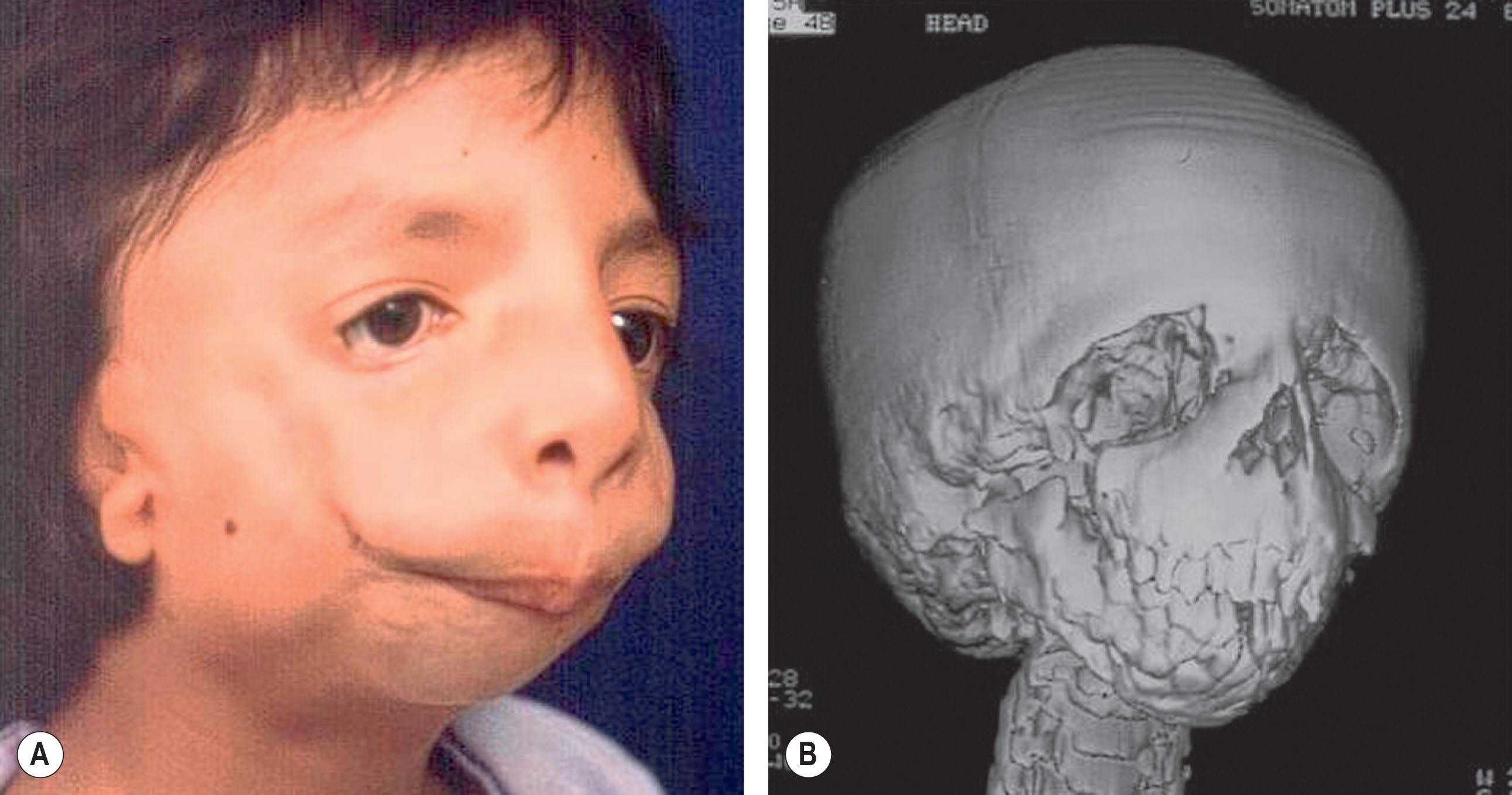Physical Address
304 North Cardinal St.
Dorchester Center, MA 02124
Treacher Collins syndrome (TCS) is characterized by a facial dysostosis with an incidence of 1 to 9 per 100,000 live births
Dysmorphology is isolated to the craniofacial region with variable presentation
Successful treatment requires a specialized interdisciplinary team to meet all the needs of a patient with TCS
The chapter presents the results of a systemic literature review of the treatment of TCS and proposes a care algorithm based on current published evidence
Access video content for this chapter online at Elsevier eBooks+ ![]()
Defects in the development of the first and second pharyngeal arches and their derivatives result in abnormal formation of the craniofacial complex, consequently giving rise to facial dysostoses. The group of facial dysostoses includes Treacher Collins syndrome (TCS), for which a genetic cause can be found in the TCOF1, POLR1B, POLR1C, POLR1D genes. Other diagnoses that are categorized as facial dysostosis are Nager syndrome, Miller syndrome, and Burn–McKeown syndrome. Mutations in the TCOF1 gene are mostly found and follow an autosomal dominant mode of inheritance. Characteristic facial features in TCOF1 -based TCS involve hypoplasia of the zygomatic arches (99%), mandible (87%), conductive deafness (91%), microtia (71%), coloboma of the lower eyelid (65%) with partial to total absence of eyelashes and down-slanting palpebral fissures (100%), and cleft palate (22%) ( Fig. 29.1 ). The presenting phenotype can range from very mild to severe, even within one family, and intelligence is usually normal. The prevalence of TCS is 1 to 9 in 100,000 live births.

In this chapter, recommendations for the treatment of patients with TCS are given based on the current available literature that was graded according to the level of evidence (see Algorithm 29.1 ). Most of these recommendations are also applicable to the other types of facial dysostosis.
As a sequel to the systematic review by Plomp et al ., a similar literature search was undertaken in Embase, PubMed, Web of Science, and Cochrane from January 2014 to January 2020. The search term was “Treacher Collins”. Excluded were proceedings, book chapters, case reports, no abstract available, inaccessibility of the full text, and studies not related to clinical practice.
Included were English-language clinical studies related to therapy, diagnosis, or risk of concomitant diseases, that included at least five TCS patients. Seven functional topics were investigated: upper airway; the ear, hearing, and speech; the eye and lacrimal system; growth, feeding, and swallowing; the nose; psychosocial factors; and craniofacial reconstruction. All the studies were included per topic of interest and a level of evidence was assigned. Level of evidence was based on the American Society of Plastic Surgeons Evidence-Based Clinical Practice Guidelines .
Of the original systematic review by Plomp et al ., only the papers that were graded level I, II, or III and were published in 2000 or later were incorporated in this chapter. If a paper had a sequel from the same institute with a longer follow-up, the first paper was disregarded.
The number of eligible papers in the four databases were 293 in EMBASE, 118 in PubMed, 100 in Web of Science, and none in Cochrane. After applying the selection criteria and removing double citations, 18 papers published between 2014 and 2021 were left. The level of evidence per paper is provided in Table 29.1 . A total of 17 papers in the systematic review by Plomp et al . were selected as described, summing up to 35 papers that are included in this chapter, and contributed to the recommended algorithm in Algorithm 29.1 .
| Reference | Title of article | Topic(s) | LEBM |
|---|---|---|---|
| Geirdal 2015 | Living with orofacial conditions: psychological distress and quality of life in adults affected with Treacher Collins syndrome, cherubism, or oligodontia/ectodermal dysplasia—a comparative study | psychosocial | III |
| de Oliveira 2018 | Patient-reported quality of life in the highest functioning patients with Treacher Collins syndrome | psychosocial | III |
| Lodovichi 2018 |
|
psychosocial | IV |
| Cobb 2014 | The surgical management of Treacher Collins syndrome | craniofacial | IV |
| Nguyen 2016 | Long-term orthognathic surgical outcomes in Treacher Collins patients | craniofacial | IV |
| Esenlik 2017 | Mandibular and maxillary cephalometric analysis of Treacher Collins syndrome | craniofacial | IV |
| Ma 2015 | Reduced three-dimensional airway volume is a function of skeletal dysmorphology in Treacher Collins syndrome | upper airway | III |
| Biskup 2018 | Decannulation and airway outcomes with maxillomandibular distraction in Treacher Collins and Nager syndrome | upper airway | III |
| Ali-Khan 2018 | Treacher Collins syndrome and tracheostomy: decannulation using mandibular distraction osteogenesis | upper airway | III |
| Hopper 2018 | Counterclockwise craniofacial distraction osteogenesis for tracheostomy-dependent children with Treacher Collins syndrome | upper airway | IV |
| Bergeron 2019 | The effect of cleft palate repair on polysomnography results | upper airway | III |
| Ribeiro 2020 | Three-dimensional upper airway assessment in Treacher Collins syndrome | upper airway | III |
| Van der Plas 2020 | Functional outcomes in patients with facial dysostosis and severe upper airway obstruction |
|
III |
| Åsten 2014 | Associations between speech features and phenotypic severity in Treacher Collins syndrome | speech | III |
| Golinko 2016 | Long-term surgical and speech outcomes following palatoplasty in patients with Treacher Collins syndrome | speech | IV |
| Plomp 2015 | Nasal sequelae of Treacher Collins syndrome | nose | II |
| Ma 2015 |
|
nose | II |
| Franchi 2015 | Orbital soft tissue surgery for patients with Treacher-Collins or Nager syndrome. A new surgical approach with early correction of soft tissue: prospective study. | eyes | IV |
Become a Clinical Tree membership for Full access and enjoy Unlimited articles
If you are a member. Log in here